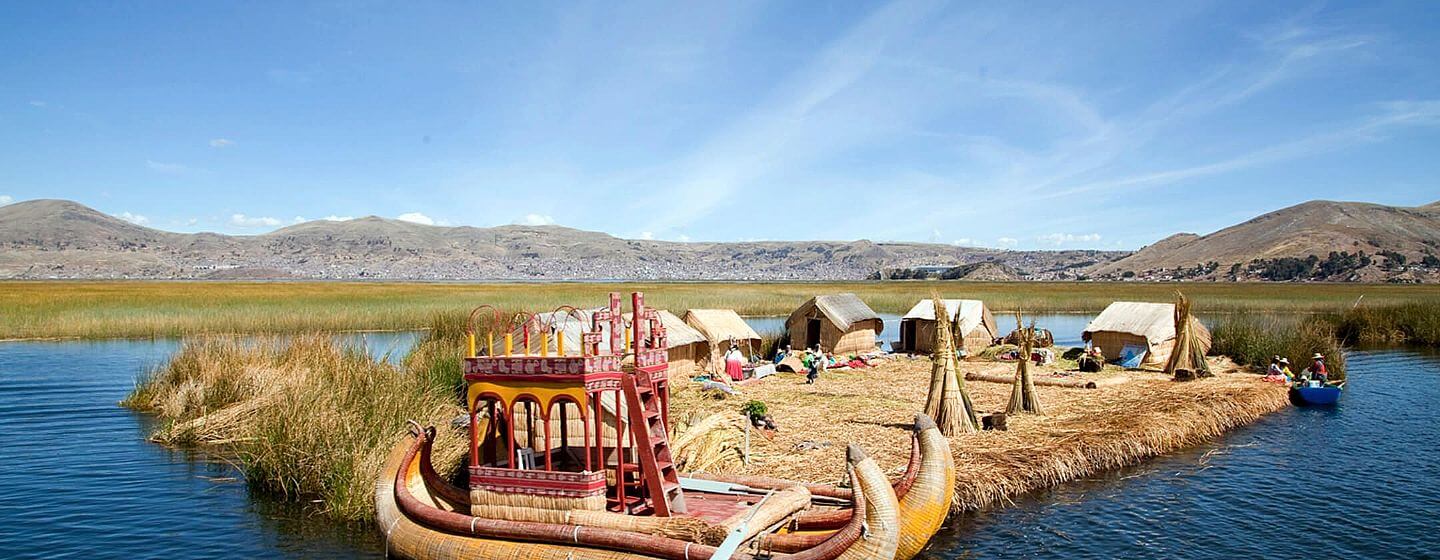The highest navigable lake in the world is a spectacle wherever you look at it. Surrounded by dense vegetation where the reeds prevail, it is inhabited by various islands, and each one of them has a different story to tell.
Taquile, Amantaní, the floating islands of Uros, offer experiences where it is possible to live directly the tradition and customs of a people that has known how to rescue the best of its environment and coexist harmoniously with it.
What is Lake Titicaca?
The Titicaca Lake in Perú is a body of water with an area of 8562 km² located in the department of Puno, specifically between the territories of Peru and Bolivia. It is the highest navigable lake in the world and currently ranks 19th in the world by area.
Titicaca Lake in Perú is one of the most famous attractions in Peru, which is why it receives thousands of visitors daily. Its climate is temperate in the areas near the Lake, but cold in the parts near Puno. Likewise, they tend to have abundant rains during the months of December to April.
What is the meaning of Titicaca?


This lake has this characteristic name thanks to a legend of the arrival of the Inca kings. The word “titi” means puma, and “caca” means gray. The meaning of Titicaca literally translates to gray puma.
Legend has it that the first Inca emperor came down to earth on a rock on the Isla del Sol, that is Lake Titicaca, and it is said that the shape of this gray rock on which he descended had the appearance of the head of a puma, hence the meaning of Titicaca is translated from gray puma.
Features of Titicaca Lake in Perú
Titicaca Lake in Perú is notable for its size, its height, its origin and its influence on the climate of the plateau, and on the lives and actions of the inhabitants. Its outline, extraordinarily capricious mind, presents cut coasts that originate peninsulas, bays and straits, whose reduced proportions suggest the presence of a miniature world.
In its territory there are various towns, large and small with a population that exceeds half a million inhabitants, and whose life and subsistence depend on the lake, which presides over the economy of the region.
Its transparent and somewhat warm waters are deep blue in color and never freeze, while its streams and rivers tend to freeze on harsh winter mornings. This is attributed to the salts it contains in solution. Meteorological phenomena, storms and lightning, occur frequently and in a very violent way.
The storms are of great appearance and extraordinary intensity although of short duration, forming foamy ridges in the waters. On dark nights there are usually phosphorescence phenomena.
The depth varies. Insignificant on its banks, it is noticeable in other points, such as on the island of Soto, where it is close to 300 meters. The water is drinkable, although in bad taste, and its temperature ranges between 11 ° and 13 °, without changing with depth.
The Uachu, a kind of silty algae, floats in the lake; and on the banks, forming bushes through which you have to make your way, creating ponds and labyrinths, the most useful cattail, which is used above all in the construction of the famous rafts that cross the lake. But also with it the men braid their ropes and cover their houses.
A prehispanic cemetery
Considered the largest cemetery in the ancient world, the Sillustani Archaeological Complex boasts impressive funerary monuments.
A pre-Inca cemetery that had huge circular chullpas that served as tombs for relatives of the Collas and Incas. Large buildings oriented towards where the sun rises, in front of Lake Umayo at 4,000 meters above sea level.
There is no doubt that this majestic destination holds endless natural treasures that are waiting for you to discover them. Come and visit it and live an unforgettable experience with the beauty of the Peruvian Altiplano.
Floating Islands in Titicaca
Within the long list of floating islands in Titicaca that rest on the lake, there are three that are the most visited daily by tourists.
Uros Island
Set of floating islands in Titicaca built from reeds that rest on the crystal clear waters of the lake. A place inhabited by people of Aymara origin, considered one of the oldest Andean civilizations, because they developed long before the Incas.
A citadel on the water that has 40 interconnected islands that have houses, schools and churches. And with a population that sustains its economy through activities such as fishing, crafts, tourism and bartering.
Taquile Island
Known worldwide for its textile works, this island inhabited by Quechua speakers is characterized by the hospitality that it offers to its visitors, who experience experiential or rural tourism by staying in their homes and thus learning more about the community. In addition, it is a perfect destination for adventure tourism, traveling the 567 steps before reaching the highest part of the island.
Amantaní Island
Located three hours by boat from the city of Puno, this island is considered the largest on Lake Titicaca. It is known as the “island of love” due to its majestic fields, huge eucalyptus trees and beautiful flowers such as the cantuta. A virgin town where residents and travelers move from one place to another on foot, allowing them to experience experiential tourism.
What to do in Puno?
Enjoy the textile art
Something that few know is that since 2005, the textile art of the island of Taquile in Lake Titicaca, was declared a “Masterpiece of the oral and intangible heritage of humanity” by Unesco. This is because the garments that people use tend to retain pre-Columbian features both in their quality, design and symbolism.
Floating islands of the Uros in Titicaca
This group of floating islands in Titicaca have been created by the Uru ethnic group, calling themselves the Kotsuña or “people of the lake.” It is said that they had to flee to the lake after the Inca Pachacútec invaded them.
The lake port of Puno
It is located in the bay of Puno and has a pier managed by the Peruvian Navy. In that place we can see a boat that was bought in Europe, built on the lake and is currently used for tourist excursions around the lake.
Tour to Lake Titicaca
- City Tour Puno
- Sillustani Tour
- Full Day Tour to Uros and Taquile
- Tour to Amantani & Taquile Island 2 Days
Tips for travel to Titicaca Lake in Perú
- Wear sunscreen.
- Whenever you go on your walks, wear hats and sunglasses.
- Likewise, it is recommended to wear a lot of warm clothing and to always be prepared for the rain, due to the freezing weather. To encourage you to visit Lake Titicaca for a weekend.










